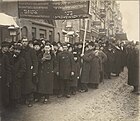Morgnshtern
Morgnshtern was repeatedly targeted by the Polish authorities; between 1929 and 1934, 23 local Morgnshtern branches were closed down. In 1937 Morgnshtern had prepared a delegation to take part in the Workers Olympics in Antwerp, Belgium, but the Polish government refused to give travel visas to the athletes.[3]
The development of socialist sports was markedly affected by the rise of
Morgnshtern ceased to function as Poland was occupied by Germany. Many of the athletes of the organisation became resistance fighters during the war.[5] Morgnshtern was revived after the war.[6] Warsaw "Jutrznia-Morgnshtern" is the only remaining Morgnshtern branch.[citation needed]
Socialist sporting
The most popular activity of Morgnshtern was gymnastics. This was followed by ritmika (eurythmics), which mainly had female participants.[9]
However, in order to increase recruitment the organisation eventually began opening up for more individually oriented competitive sports such as
The organisation was even more vocally opposed to boxing, and had proposed banning boxing from the Socialist Workers' Sport International at the 1929 SWSI congress.[10] However, the Warsaw branch of Morgnshtern set up a boxing club in late December 1935, which was rather successful in the late 1930s.[2][9]
Relations with ZRSS and SWSI
A delegation of Morgnshtern participated in the 1927 congress of the Socialist Workers' Sport International.[7] Morgnshtern had a complicated relationship with the Polish Workers' Sport Federation (ZRSS), due to political antagonism between the Bund and the Polish Socialist Party (which dominated the ZRSS). The two organisations clashes at the 1929 Prague congress of the Socialist Workers' Sports International, as Morgnshtern demanded to be recognized as a separate section and not as an affiliate of the Polish ZRSS. In the end, the congress accepted the demand. Morgnshtern sent its own delegation to the 1931 Workers Olympics in Vienna.[3]
Cultural and social activities
The summers Morgnshtern would rent a swimming pool, and offer swimming lessons to its members. In the winters, from 1933 onwards, the organisation had an ice-skating rink in Warsaw.[9]
Name
| Part of a series on |
| Bundism |
|---|
 |
| 1890s to World War I |
|
| Interwar years and World War II |
| After 1945 |
|
| People |
| Press |
| Songs |
| Associated organisations |
| Splinter groups |
|
| Categories |
The full name of the organization was Arbeter Gezelshaft far fizisher Dertsiung "Morgnshtern" in Poyln in Yiddish, and Robotnicze Stowarzyszenie Wychowania Fizycznego "Jutrznia" w Polsce in Polish. After the 1929 congress of the Socialist Workers' Sport International, the organisation added and 'Jewish section of the Workers' Sports International' (yidishe sektsie fun arbeter sport internatsional) to its name.[3][11]
Emblem
The emblem of Morgnshtern featured a javelin thrower, illustrated in the style of a classic Greek statue, in front of belching smokestacks. The emblem also had the name of the organisation in Yiddish and Polish.[11]
References
- ^ Brenner, Michael, and Gideon Reuveni. Emancipation Through Muscles: Jews and Sports in Europe. Lincoln: University of Nebraska Press, 2006. p. 93-94
- ^ a b Brenner, Michael, and Gideon Reuveni. Emancipation Through Muscles: Jews and Sports in Europe. Lincoln: University of Nebraska Press, 2006. p. 97, 100
- ^ a b c d Kugelmass, Jack. Jews, Sports, and the Rites of Citizenship. Urbana: University of Illinois Press, 2007. p. 119-120
- ^ Brenner, Michael, and Gideon Reuveni. Emancipation Through Muscles: Jews and Sports in Europe. Lincoln: University of Nebraska Press, 2006. p. 53, 60-61
- ^ a b "Archived copy" (PDF). Archived from the original (PDF) on 2011-06-15. Retrieved 2009-10-13.
{{cite web}}: CS1 maint: archived copy as title (link) - ^ The Jewish Labor Bund Bulletin, Vol II, No 16-17, April-May, 1949. p. 4
- ^ a b c Brenner, Michael, and Gideon Reuveni. Emancipation Through Muscles: Jews and Sports in Europe. Lincoln: University of Nebraska Press, 2006. p. 51-53
- ^ a b Kugelmass, Jack. Jews, Sports, and the Rites of Citizenship. Urbana: University of Illinois Press, 2007. p. 115-116
- ^ a b c d "Outlook Magazine - Reporting on the News Trends in Canada".
- ^ Kugelmass, Jack. Jews, Sports, and the Rites of Citizenship. Urbana: University of Illinois Press, 2007. p. 117
- ^ a b Kugelmass, Jack. Jews, Sports, and the Rites of Citizenship. Urbana: University of Illinois Press, 2007. p. 123
